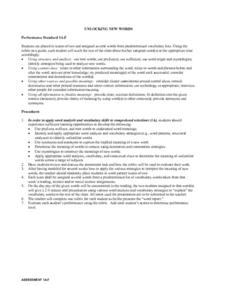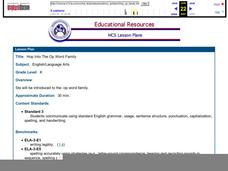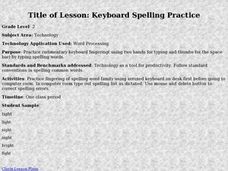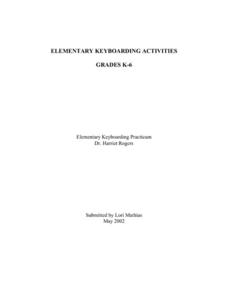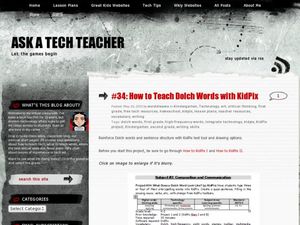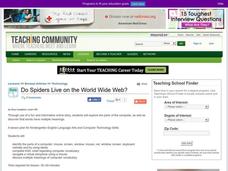ReadWriteThink
Word Recognition Strategies Using Nursery Rhymes
As a class, scholars read the poems, Humpty Dumpty, Peter, Peter, Pumpkin Eater, and Jack and Jill, in order to identify words with the same ending sound. Using their rhyming skills, learners brainstorm additional words...
Curated OER
Word Processing Can Be Lots of Font!
Explore the basic functions of word processing programs. Young computer users practice deleting, inserting, and changing text. They experience using computer functions as they copy a required poem and complete various computer exercises....
Curated OER
Unlocking New Words: Partner Presentations
Following extensive modeling about how to apply word analysis and vocabulary skills to learn new words, partner teams create brief word presentations to teach new vocabulary to the class. Preselect words from upcoming social studies,...
Curated OER
Deciphering Word Problems in Order to Write Equations
Help young mathematicians crack the code of word problems with this three-lesson series on problem solving. Walking students step-by-step through the process of identifying key information, creating algebraic equations, and finally...
Do2Learn
Technology Picture Cards
From smart phone to tablet computer, class members become familiar with technology vocabulary, and the action that make it accessible.
Curated OER
MS Word Skills Assessment
Young scholars are assessed on their use of the Microsoft Word program. In this word processing assessment, students are asked to complete a list of tasks in the Microsoft Word program to determine their knowledge of the program.
Curated OER
Hop Into the Op Word Family
An engaging lesson plan that teaches the /op/ word family is here for you. In it, learners utilize a PowerPoint and a worksheet embedded in the plan to help them better-understnad this word family. This fun lesson plan should be a hit...
Curated OER
Keyboard Spelling Practice
After teaching kids the hand placement generally used for typing, give them a short list of common words to practice with. They type tight, light, sight, night, bright, and fight as fast and accurate as possible.
Curated OER
Introduction to Microsoft Word
Second graders elaborate on the classroom writing practices. They locate the various parts of the keyboard such as, space bar, shift key, delete key, etc. They also type a short piece of writing on a word processor. This is a teacher...
Curated OER
Introducing Microsoft Word
Students explore Microsoft Word. In this technology lesson, students discover the basic word processing commands. Students enter and change text within the word document.
Curated OER
Fix It
Word processing practice and vocabulary blend with proofreading in a multi-purpose lesson that makes excellent use of an hour in the computer lab. Learners edit the grammatical, spelling, and punctuation errors in a given paragraph (not...
ReadWriteThink
Concept Map
When you think of one topic, related ideas and details invariably follow. That's concept mapping! Jot down ideas with a straightforward graphic organizer that works both electronically and as a printed resource.
New York State Education Department
TASC Transition Curriculum: Workshop 2
Flipped classrooms and online tools killed the chalkboard! An awesome, hands-on technology workshop asks teachers across all content areas. to examine model lessons, become familiar with research, and explore tech tools they can...
Nebraska Department of Education
Curriculum For Careers
Learners explore potential learning, earning, and living goals that align with their personal goals and interests in a comprehensive unit that includes complete lesson plans, interactive notebooks, worksheets, overheads, rubrics,...
Curated OER
Performance-Based Assessment Practice Test (Grade 9 ELA/Literacy)
Ready your pupils for Common Core testing by providing them with practice. For this assessment, learners read and respond to a variety of different passages in both multiple-choice and essay format. An online version is also included.
Goodwill Community Foundation, Inc.
Saying Hello: Common Greetings in Spanish
The first thing Spanish learners need to know is how to say hello! An interactive resource guides beginners into basic Spanish greetings with audio prompts and self-assessment checklists.
Mrs. Burke's Math Page
Let Them Eat Pi
Looking for a fun and creative way to celebrate Pi Day? Then this is the resource for you. From a scavenger hunt and trivia contest to PowerPoint presentations and skills practice worksheets, this collection of materials is a...
Curated OER
Synonyms and Antonyms
Mix up your writing lessons by having kids look at recent newspaper articles instead of their own work. They work in pairs and rewrite sports news articles using synonyms and antonyms for a set number of words. Then they share their work...
Curated OER
Word Reference Materials
A class discussion on reference materials opens up a lesson plan on how to use these important resources. They discover that dictionaries, glossaries, and thesauruses are called word reference resources, and they practice using them. The...
Curated OER
Elementary Keyboarding Activities
Listen to the sound of children's fingers flying across their keyboards as they perform these fun typing lessons. From creating alphabet books and multimedia presentations to researching presidents and writing class...
Noyce Foundation
Time to Get Clean
It's assessment time! Determine your young mathematicians' understanding of elapsed time with this brief, five-question quiz.
Curated OER
How to Teach Dolch Words with Kid Pix
Learners use KidPix computer program to learn Dolch sight words. In this technology and language lesson, students type their Dolch sight words into KidPix to create a quasi-sentence.
Curated OER
Using Technology in the Early Childhood Classroom
Students explore ways to use technology. They create pictures with Kid Pix software to describe something about themselves. They create pictures os something they did over the summer and write sentences to accompany their pictures. They...
Curated OER
Do Spiders Live on the World Wide Web?
Explore the parts of a computer and discover that words have multiple meanings. Your class will verbally identify the parts of a computer including the mouse, screen, window, net, and keyboard. They will also complete a KWL chart,...


